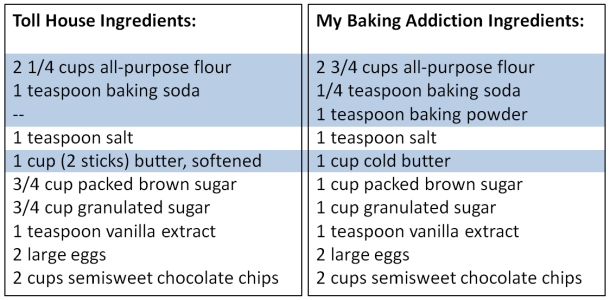How would you describe your perfect chocolate chip cookie? Thin and chewy? Ultra-crispy? Thick and cakey? Whatever your preference, knowing how to manipulate the ingredients in a basic cookie recipe is the first step toward chocolate chip cookie bliss. At last week’s “Science of Cookies” student event, graduate student Kendra Nyberg showed us how to achieve two very different cookie textures by riffing off of the classic Toll House chocolate chip cookie recipe.
Thin, Chewy Cookies from Smitten Kitchen
These cookies are all about moisture. A wetter cookie dough spreads more during baking, creating a much thinner cookie. Extra moisture also promotes gluten development in the cookie dough, creating a slightly denser, chewier cookie. This recipe from Smitten Kitchen maximizes moisture content by using melted butter, less flour, less egg white (which can dry out cookies), and a higher brown-to-white sugar ratio (brown sugar can help retain moisture) than the classic Toll House Recipe.
Thick, Soft Cookies from My Baking Addiction
Where the previous cookies craved moisture, this recipe from My Baking Addiction removes extra moisture to create thicker, less chewy cookies. Increasing the flour content and using extra cold butter creates a drier dough that spreads less easily in the oven; adding baking powder to the dough lends extra fluffing power. The reduced moisture in this dough also limits gluten formation for a slightly softer (less chewy) cookie.
Of course, this is barely the tip of the cookie engineering iceberg. There are so many ways to tweak a cookie recipe to achieve different textures. In addition to this brief introduction, the internet is full of great resources for cookie hacking. This particularly handy guide from Handle the Heat clearly show some of the ingredient manipulations described above. If you end up experimenting with your favorite cookie recipes, be sure to tell us about it in the comments below!
 About the author: Liz Roth-Johnson is a Ph.D. candidate in Molecular Biology at UCLA. If she’s not in the lab, you can usually find her experimenting in the kitchen.
About the author: Liz Roth-Johnson is a Ph.D. candidate in Molecular Biology at UCLA. If she’s not in the lab, you can usually find her experimenting in the kitchen.





Wanted to suggest a ‘screening’ of More Than Honey and /or GMO OMG
Thank you for manipulating the Chocolate Chip cookie recipe….wish I was there to sample!
Patty Beckwith MPH, RD, CDE Outpatient Pediatric Senior Dietitian pbeckwith@mednet.ucla.edu pager 90071 310-267-9245 ________________________________
Pingback: Cookie-Baking Chemistry: How To Engineer Your Perfect Sweet Treat | EikAwaz.com
Pingback: If you ever were thinking about cookies at this time of day… | A Book and A Button
Hi,
Thank you for a fascinating article. Is it beyond the scope of your work to talk about the science of low-carb and gluten free baking? I have been playing around, with success, using a combination of almond meal, coconut flour, and xylitol. It is a trial and error process and I would love to know the science behind it. Most low carb, gluten free desserts are pretty sad, I admit. After much recipe research and hit and miss experimentation, I’ve created some things that I think are good and I’d love to learn more about it, if you have the inclination or interest. If you’d like to take a look at some of my recipes you can go to http://www.preheatto350.com (not a plug :-), just the best way I can think of to describe my recipies).
The cakes work great. The pizza crust tastes good and works well enough. The cookies, however, are another matter. I’ve only had success with a peanut butter cookie. It’s quite fragile but does hold together if the butter is softened but still a little cool when mixed in.
Just thought I’d ask since there is a lot of interest in low carb and gluten free baking and your information is so interesting and well presented. I’d love to actually know WHY the arrowroot helps the pizza crust crisp, or why I need lots more eggs and baking powder in the cake, and why and when to use baking soda.
Thanks again for a great site,
Lisa Kelso
Hi Lisa,
Thanks for all the great questions! Gluten free baking is certainly a fascinating topic that we’ll try to spend more time on in the future.
One of the most challenging aspects of gluten free baking is being able to form a coherent dough that holds together in the absence of the stretchy gluten protein networks that are developed during dough formation. As you’ve already seen, gluten free can work pretty well in baked goods where too much gluten development can be a bad thing (pie crusts, delicate cakes, crispy flatbread crusts, etc.) but is much harder when a chewy, denser texture is desired (breads, doughy pizza crusts, chewy cookies, etc.).
Until we get a chance to dive into this topic, here are a couple articles that discuss related topics:
Boozy Apple Pie – How gluten protein network development is inhibited by alcohol
Baking Without Eggs – A brief primer on common egg substitutes in baking (which can also sometimes be used to replace gluten)
Good luck and happy experimenting!
Hi Liz,
Thanks so much for your speedy reply!
I’ll take a look at the articles you mention. I’m looking forward to any future information you have on the subject. I just subscribed to your blog so I’ll be on the lookout.
Thanks again,
Lisa
Pingback: Baking Frenzy | Curuba
Why do my cookies taste bitter like a chemical?
Pingback: 14x Cookie Science - A roundup - Food Crumbles - The Food Science Blog
You might need to check on the sodium bicarbonate or baking soda content, I guess you might have added to much of it.